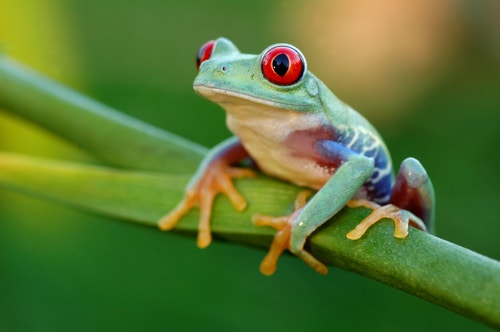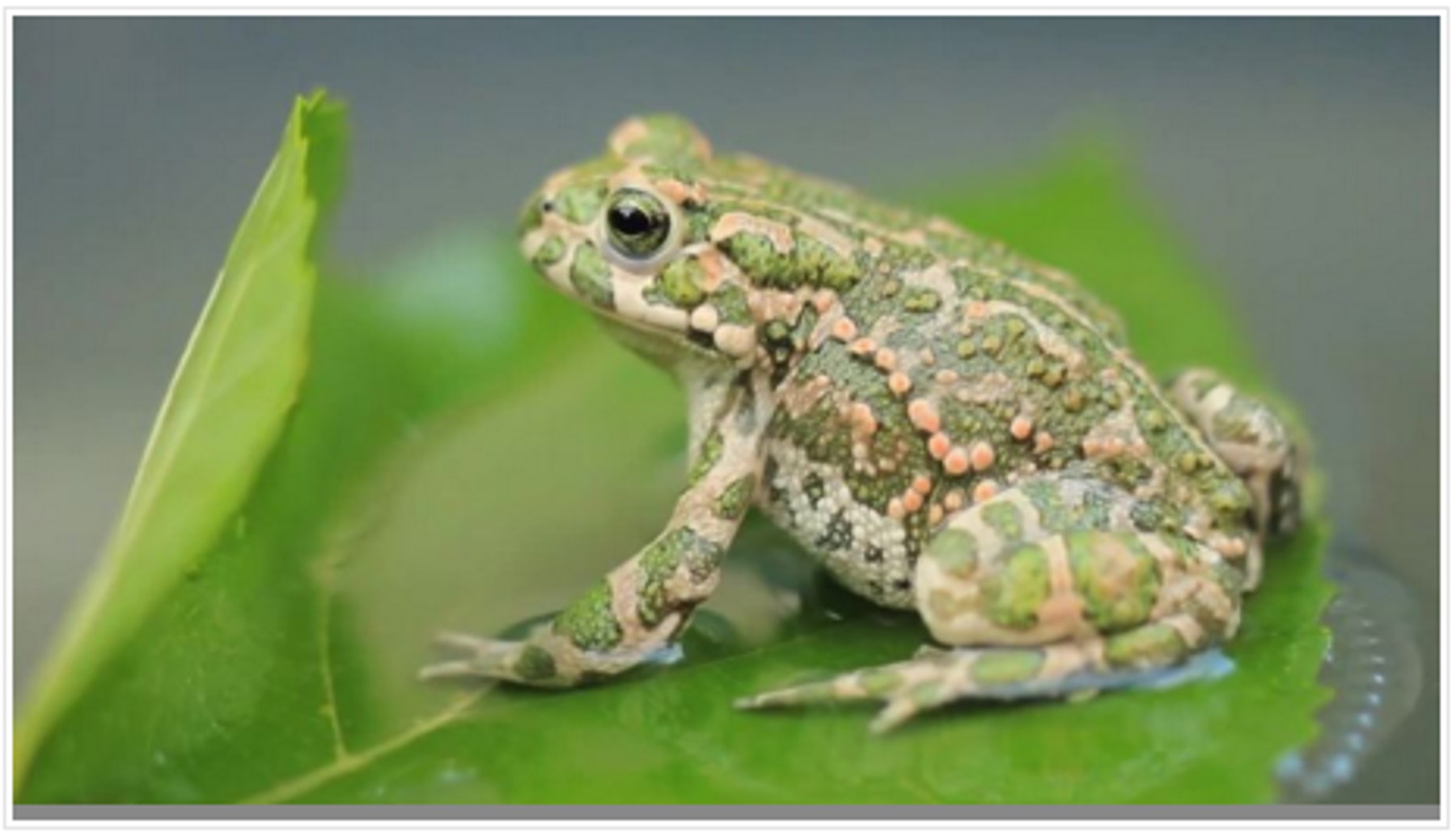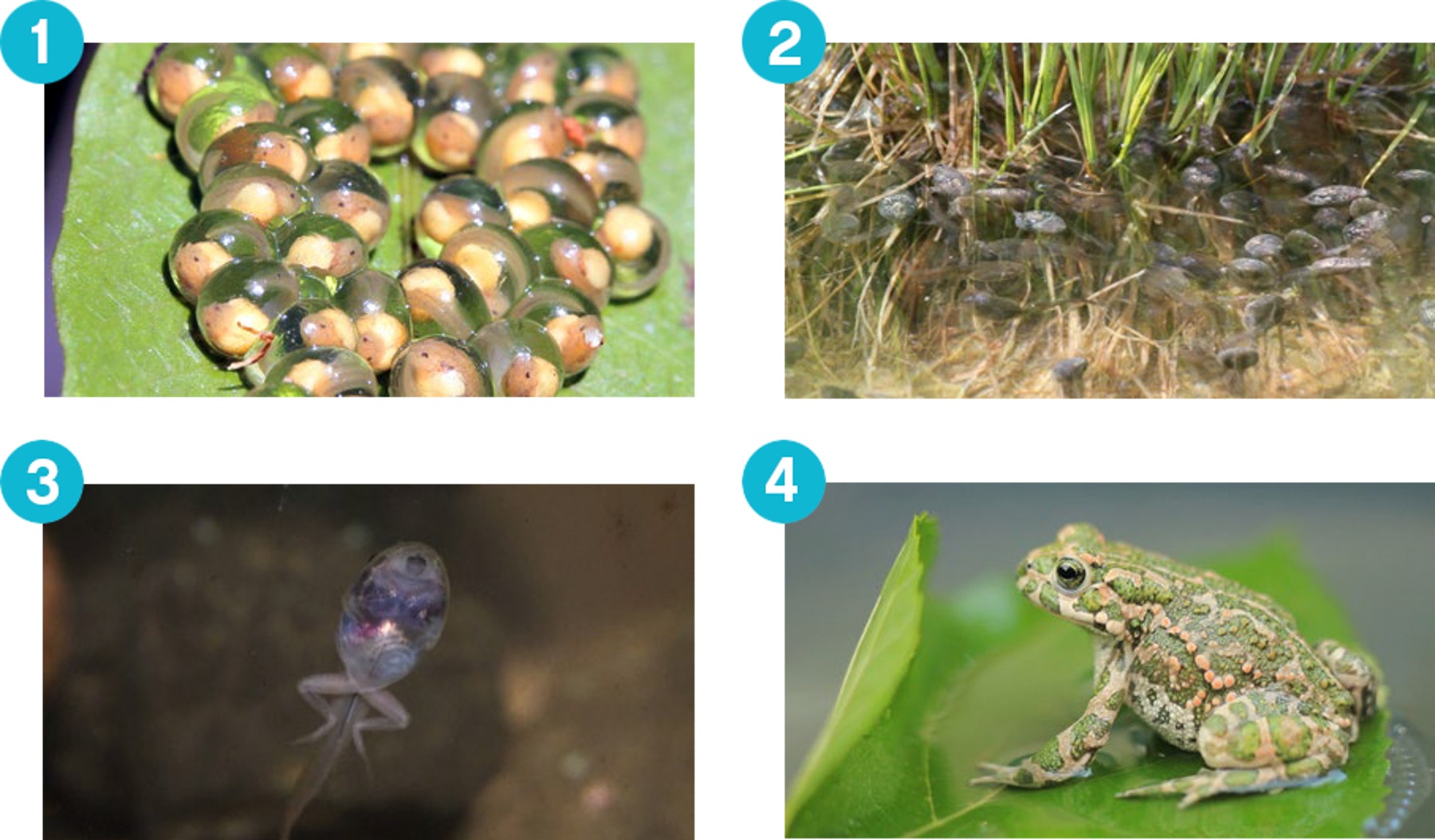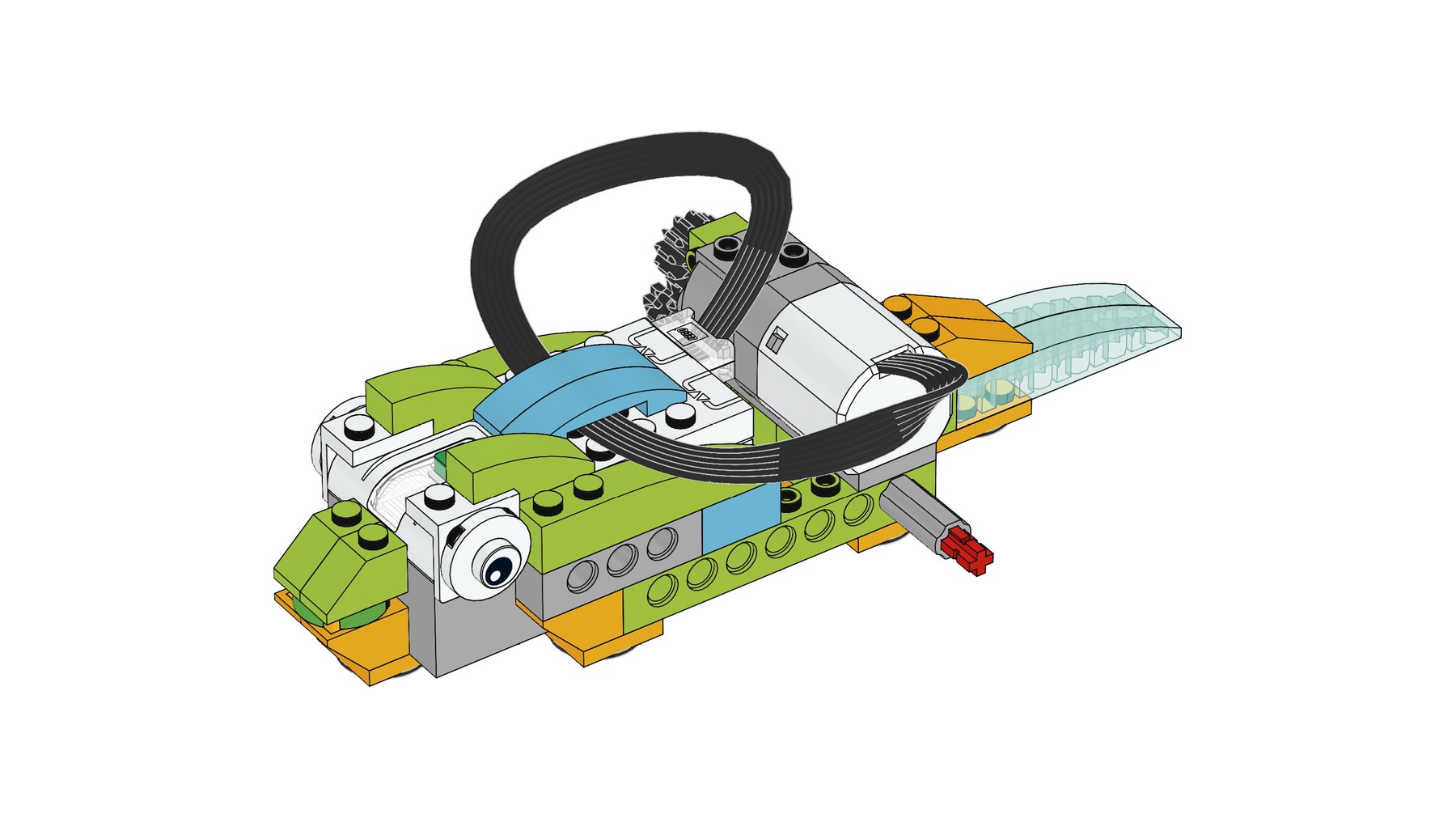Frog’s Metamorphosis
Model a frog’s metamorphosis using a LEGO representation and identify the characteristics of the organism at each stage.

1. Preparation
(15-30 minutes)
• Read the general preparation in the “Classroom Management” chapter.
• Read about the project so you have a good idea of what to do.
• Define how you want to introduce this project: Use the video provided in the project in the WeDo 2.0 Software, or use material of your own choice.
• Determine the end result of this project: the parameters to present and produce the document.
• Make sure timing allows for expectations to be met.
Important
This project uses models to represent a real-world concept. It introduces a frog’s life as one representation of a life cycle. This project is intended to be an application of students’ prior knowledge regarding life cycles of plants and animals.
2. Explore phase
(30-60 minutes)

The introductory video may set the stage for the following ideas to be reviewed and discussed with students for this project.
Introductory video
Unlike mammals, frogs go through metamorphosis during their lives:
- Frogs start their lives as eggs. Not all baby frogs will survive as many will be eaten by predators.
- When the eggs hatch, the tadpoles start looking for food sources.
- Tadpoles slowly grow legs as they become young frogs (froglets).
- For many species, after about twelve weeks, the frog has its adult shape and is ready to jump, eat flies, and reproduce.
Although this varies among frog species, the metamorphosis of a typical frog from birth to adult takes an average of sixteen weeks. Once a frog has reached adulthood, it can reproduce. There are species of frog that have a life span of less than two years, while other species may live up to fifteen or more years.

Questions for discussion
- What physical features are changing as a frog progresses from tadpole to adult?
The jaw changes shape, tail recedes, tongue for catching flies develops, hind legs and then front legs begin to grow, and lungs develop as gills disappear. This is merely a list of some of the most obvious changes that occur as a frog undergoes metamorphosis and is not intended to be an exhaustive description. - What are some links among the changes of a frog’s physical characteristics and its habitat?
Animals morph so they can survive in a new environment. Tadpoles often move from aquatic to terrestrial environments as they morph into adult frogs, so their bodies must support different ways of eating, breathing, and moving. - How are life cycles of plants and animals similar?
Plants have similar life cycles to frogs because they both change shape during their lives and have a stage where they don’t look like the adult stage (tadpole in the case of the frog, seedling in the case of the plant). - What are the stages in the life of a frog?
For frogs, it would be egg-->tadpole-->froglet (young frog)-->adult frog. For other animals, answers will vary. - Are frogs the only animal to go through metamorphoses during their life cycle?
No, butterflies and moths undergo complete metamorphoses, and dragonflies and many fish experience incomplete metamorphoses (as well as various other organisms). - Do humans go through metamorphoses? How do you know?
Although humans’ body shapes grow during their lives, they don’t change.
Allow the students to select the tool(s) they find most appropriate for capturing and sharing their pseudocode. Encourage them to use text, videos, images, sketch notes, or another creative medium.
3. Create phase
(45-60 Minutes)
1. Build a model of a tadpole (larva).
Students will start to build a tadpole with only eyes, a long tail, and, at first, no front legs. Have them take a picture of this stage or sketch it in order to document it before they morph it into the young frog.
2. Build a young frog model (froglet).
Students will follow the building instructions to morph the tadpole into a young frog that can move if activated by a program. Let the students describe the changes they note as the model progresses.
One important, new feature that has changed in the young frog is the development of back legs. The walk module used in the project uses gears. These gears move the back legs.
Students should once again document their models using pictures and/or sketches.

3. Program the young frog.
This program will turn the motor on in one direction at motor power 8 for 3 sec. and then stop it.

Suggestion
Before your students start to modify their model, have them change the parameters of the program so they fully understand it.

Morphing from a young frog (froglet) to an adult frog
After building the young frog, students should then modify it to create their own model.
There will be many possible solutions. Here are some examples:
1. Change both front and back legs.
The young frog will develop both front and back legs during its life. Students could build bigger legs in the back and create front legs. Students can also change the positions of the legs to show the different types of movements made by an adult frog. Students may modify their existing programs or create new ones to move the new legs.
2. Other changes in appearance.
Removing the tail, adding a mature tongue, changing the eye position, and adding patterns on the skin are additional ways to make the model look like an adult frog.
3. Replicate adult frog behavior.
Students could use sounds or the Motion Sensor to change the frog’s behaviour. For example, with a Motion Sensor placed on the frog’s head, it could be programmed to wait until it detects an object such as a hand and then move backward.
Important
It is important to note that because a student model will vary according to student choice, there are no building instructions or sample programs provided to students for this part of the project.
Use the model further (optional, 45-60 minutes)
The “Use the model further” section of the student project as an optional extension. Keep in mind that these tasks extend upon those of the “Use the model” section and are designed for older or more advanced students.
Frogs are amphibians that are very sensitive to the environment. For example, they have a porous skin that can allow chemicals to affect their development.
Ask students to research the effects of damaging external factors on the frog life cycle. For example:
• Changes (such as damage or destruction) of habitats: Frogs would not find a mate or would not be able to move freely or find food that they need.
• Pollution or disease: Frogs could mutate by growing an extra leg or losing one.
Have your students illustrate with their model the effect of such factors on frog behaviour and on the frog’s life cycle.
Suggestion
The framework for science education stresses that plants and animals have predictable characteristics relating to life processes, change, and growth. Animals and plants have similar growth processes, and offspring are related to the previous generations as inherent traits are realized. You could expand this modeling project to include other plants and animals.
Collaboration suggestion
Have teams compare and share their findings and have them share the impact of external factors on the frog populations.

4. Share phase
(45+ minutes)
Complete the document
Have students document their project in a variety of ways:
• Ask students to take a picture of every stage they create and prepare to discuss how the model represents a frog’s metamorphosis.
• Ask your students to compare images of their models with real-life images.
• Ask your students to record a video of them describing their project.
Present results
At the end of this project, students should present what they learned.
To enhance your students’ presentation:
• Have students explain the life cycle of the frog.
• Make sure they can explain the different stages.
• Have them compare this life cycle with other animals.
• Have them describe the limitations of their model.
• Ask them to create a display to put the frog’s metamorphosis into context.
Project assessment
NGSS project assessment rubrics
You can use these assessment rubrics with the observation rubrics grid, which you will find in the “Assess with WeDo 2.0” chapter.
Explore phase
During the Explore phase, make sure the student is actively involved in the discussion, asks and answers questions, and documents and offers responses to questions, such as, “What are the different stages of a frog’s life?” in his/her own words.
- The student is not involved in the discussion of the questions posed during the Explore phase, and no documentation is captured.
- The student contributes little to the discussion of the questions posed during the Explore phase and documents some of his/her responses.
- The student contributes sufficiently to the discussion of the questions posed during the Explore phase and adequately documents his/her responses.
- The student actively contributes to the discussion of the questions posed during the Explore phase and documents his/her responses.
Create phase
During the Create phase, make sure the student actively investigates solutions by planning, designing, and redesigning, if necessary, and can apply his/her understanding of the life cycle of a frog to represent it in a model.
- The student neglects to create a model to represent the frog life cycle that demonstrates evidence of comprehension.
- The student creates a model to represent the frog life cycle that demonstrates some evidence of comprehension.
- The student successfully creates a model to represent the frog life cycle that demonstrates adequate evidence of comprehension.
- The student creates a model to represent the frog life cycle that demonstrates evidence of a highly developed comprehension.
Share phase
During the Share phase, make sure the student can explain the life cycle of the frog and the changes it undergoes; identify limitations of their model (what is close to reality and what is not); and use important information from his/her project to create the final report.
- The student neglects to discuss the limitations of the model or the life cycle of a frog. The student does not use the information to create the final report.
- The student is able to discuss, with prompting, some of the limitations of the model and the life cycle of a frog. The student uses some information to create the final report.
- The student is able to adequately discuss the limitations of the model and the life cycle of a frog and use all necessary information to create the final report.
- The student discusses the limitations of the model and the life cycle of a frog and uses all necessary information to create the final report.
ELA project assessment rubrics
You can use these assessment rubrics with the observation rubrics grid, which you will find in the “Assess with WeDo 2.0” chapter.
Explore phase
During the Explore phase, make sure the student can effectively explain his/her own ideas through collaboration with peers.
- The student does not share his/her ideas related to the questions posed during the Explore phase and show evidence of collaboration with peers.
- The student is able, with prompting, to share his/her ideas through collaboration with peers during the Explore phase.
- The student adequately shares his/her ideas through collaboration with peers during the Explore phase.
- The student uses details to share insightful ideas through collaboration with peers during the Explore phase.
Create phase
During the Create phase, make sure the student uses precise language and appropriate vocabulary and makes appropriate choices in communicating concepts using the Documentation tool.
- The student does not use precise language or vocabulary appropriately and demonstrate thoughtful choices in communicating concepts with the Documentation tool.
- With prompting, the student can incorporate some appropriate vocabulary and generally makes appropriate choices in communicating concepts using the Documentation tool.
- The student uses precise language and appropriate vocabulary and makes appropriate choices in communicating concepts using the Documentation tool.
- The student uses precise language and advanced vocabulary and makes appropriate choices in communicating concepts using the Documentation tool.
Share phase
During the Share phase, make sure the student describes the relationship among the model and scientific concepts related to the life cycle of a frog using appropriate vocabulary.
- The student does not effectively describe the relationship among the model and any scientific concepts related to the life cycle of a frog.
- The student describes the relationship among the model and scientific concepts related to the life cycle of a frog, but there are inaccuracies and relevant pieces of information are missing.
- The student adequately describes the relationship among the model and scientific concepts related to the life cycle of a frog using appropriate vocabulary.
- The student describes, in detail, the relationship among the model and scientific concepts related to the life cycle of a frog using advanced vocabulary.
5. Differentiation
To ensure success, consider giving more guidance on building and programming, such as:
• How to make back legs longer or how to create front legs
• How to change its appearance by changing its eyes
• Use the Motion Sensor to detect predators and escape.
Also, be specific about how you would like them to present and document their findings, such as with a sharing session among teams, for example.
Suggestion
For more experienced students, you may want to allow them extra time for building and programming to allow them to create models of different animals. Then also ask them to compare and contrast the different animal life cycle models.
You could also revisit the model of the tadpole and determine a way to construct a functional tail. Review the turn base module in the Design Library to get help.
Use the model further
To use the model further, ask your students to study external factors that can influence the life cycle of the frog and its effect on the frog’s body. Examples could include: pollution effects, predator elimination, and population changes.
Students’ misconceptions
Students might think metamorphosis occurs for all animals. Certain animals have very similar life cycles, and some have very different ones. For example, mammals and insects have very different life cycles, but a horse and a cat are both similar because they are mammals. Explore the following terms while defining a life cycle.
Teacher Support
Students will:
Explore what you know about the stages in the life cycle of a frog, from birth to adult.
Create and program a model of a young frog and then of an adult frog.
Document the changing characteristics of your model throughout different stages of a frog’s life.